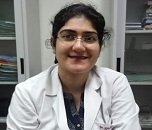Day 1 :
Keynote Forum
Liane Deligdisch
Icahn School of Medicine at Mount Sinai, USA
Keynote: Effects of hormone therapy on the uterus
Time : 09:30-10:05

Biography:
Liane Deligdisch has completed her Graduation at Medical School in Bucharest, Romania, trained in Obstetrics-Gynecology and Pathology in Israel where she became an Associate Professor of Pathology at the Tel Aviv Medical School. In USA, she was a Visiting Professor at the Magee Women's Hospital in Pittsburgh, Pa and trained in Gynecologic Pathology at the Boston Free Hospital for Women (Harvard Medical School) and in Perinatal Pathology at The Mount Sinai School of Medicine in New York where she is an attending and tenured full Professor since 1986. She founded the Division of Gynecologic Pathology and the Course of Gynecologic Pathology at the Medical School of the Mount Sinai Medical Center. She has published 148 peer-reviewed articles of which numerous studies are focused on uterine pathology related to hormonal effects and carcinogenesis, and on ovarian pathology. She has edited and authored seven textbooks on Gynecologic Pathology including child and adolescent disorders, early diagnosis of gynecologic malignances, uterine and ovarian neoplasms. She gave numerous courses and lectures at national and international meetings, received awards and in 2007 became an elected member of the French National Academy of Medicine.
Abstract:
Hormone therapy is widely prescribed to women of all ages throughout the world. Younger women are using oral contraceptives, or hormonal ovulation stimulation for infertility. Peri- and postmenopausal women are treated with hormone replacement therapy, a controversial issue with challenging new aspects. For breast cancer and uterine neoplastic lesions, there is hormonal adjuvant therapy. The effects on the uterus, especially on the endometrium are multiple, usually prompt and highly versatile due to the presence of binding steroid receptors. The most commonly used hormones are Estrogens (E) and Progesterone (P), normally present and responsible for reproductive functions in premenopausal women. Prolonged and unopposed E may result in abnormal proliferation, hyperplasia and neoplasia of endometrial tissue, and can be reverted to some extent by P therapy. Endometrial Carcinoma (EC), the most common gynecologic malignancy in the USA and in most of the industrialized world, often associated with overweight, diabetes and increased longevity, is also related to hyperestrogenism in the majority of cases. Type I hyperestrogenism-associated EC has a much better clinical outcome than type II which is possibly independent from hormones. A potential viral cofactor (HMTV) has recently been demonstrated in the latter. Tamoxifen, a non-steroidal estrogen derivative is successfully used in breast cancer due to its antiestrogenic effect on breast tissue but can have an estrogen-agonist effect on the endometrium especially in elderly patients who may develop endometrial polyps, hyperplasia and cancer, as demonstrated in the large series of 700 patients by this author and team. Uterine leiomyomas, the most common benign uterine tumors can be effectively treated with hormones, especially GnRH agonists as analyzed by the same team, due to a reversible menopausal effect manifested by shrinking of the volume of these sometime very large tumors.
Keynote Forum
Michael J Sinosich
Douglass Hanly Moir Pathology, Australia
Keynote: Non-invasive prenatal screening and then some?
Time : 10:05-10:40

Biography:
Michael J Sinosich has completed his PhD on Trophoblast Physiology and PAPP-A. His research interests include non-invasive assessment of fetomaternal wellbeing. He is the Director of Prenatal Testing (DHM Pathology) and serves as Consultant at Pictor Ltd, a developer and manufacturer of multiplexed microELISA assay platform. He has published/presented numerous papers in reputed journals and holds several patents.
Abstract:
By definition, non-invasive prenatal screening (NIPS) encompasses all testing modalities applied prenatally in order to identify a subset of obstetric population deemed to be at increased risk for disorder being screened. So, if we focus on screening for fetoplacental wellbeing, technically, this includes ALL current screening modalities: proteomic (PAPP-A, FbhCG, AFP), ultrasonographic (NT), extracellular (cf) DNA and fetal cells. Patients with positive screening results should be counseled and advised to seek confirmatory testing, prior to any definitive management action. In figure are shown the various sources of extracellular (cf) and intracellular (g) DNA in the mother. Whilst efficacy of cfDNA screening for trisomy 21 is well established, the physiology and trophoblastic source of cfDNA limits its screening application. More recently, NIPS has been applied to fetoplacental cells as a source of fetal genomic (g) DNA. Cellular targets include nucleated fetal red blood cells (NRBS), mononucleated cytotrophoblast (CT) and polynucleated syncytiotrophoblast (SCT) cells. Cell enrichment may be mediated immunologically or physically, at present fetal cell isolation is achieved by laser dissection. Whilst providing a pure fetal cell, this technology is labor intensive and limited in application to high risk populations. This technology is not applicable to population based screening. Non-invasive prenatal screening has progressed from proteomic, as current first trimester programmes, to ultrasonographic and, more recently, to cfDNA. Whilst limitations of cfDNA are understood and accepted, this has not hampered to uptake of cfDNA based screening. With improvements in molecular technology and application to single cells, we are on the verge of entering into the era of comprehensive prenatal fetal genotyping, including exosome sequencing, based on analysis of gDNA.
Keynote Forum
Rebecca Kimble
University of Queensland, Australia
Keynote: Diagnosis and management of complex reproductive outflow tract disorders in adolescents
Time : 11:00-11:35

Biography:
Professor Rebecca Kimble is a Paediatric and Adolescent Gynaecologist (PAG) with 18 years’ experience establishing and running the Queensland PAG service at the Quatenary Royal Brisbane and Women’s and Lady Cilento Children’s Hospitals. She has extensive experience with the management of complex congenital conditions of the female reproductive system, and over 25 years’ experience with tertiary obstetrics in clinical and leadership positions. She is an Independent Health Advisor to the Australian Federal Government on Women’s health. She has multiple publications in complex congenital conditions and is a member of the North American Society for Paediatric and Adolescent Gynaecology. She is medical lead Quality Improvement for the Queensland Government. She is founder and director of Queensland Clinical Guidelines, a globally utilized portal for evidence based Clinical Guidelines in Maternity and Neonatology. She chairs the Queensland Maternity and Neonatal Clinical Network and has achieved a reduction in unnecessary variation in clinical care.
Abstract:
Introduction
Outflow track disorders in the PAG population are sufficiently rare for most general gynaecologists to have had experience and confidence in recognition and management of this highly complex cohort of young women, most of whom will need more than the anatomical correction, with considerable attention to their psychological wellbeing.
Methods
We retrospectively reviewed the medical records of patients with uterine, cervical and vaginal anomalies that presented to the PAG service from 2002 to 2017. The anomalies were classified according to the ESHRE/ESGE classification.
Results
A total of 102 cases of female congenital anomalies of the reproductive tract were identified from a cohort of 635 patients referred, of which 40 were obstructive anomalies. These conditions included patients with lower vaginal atresia managed by creation of surgical neovagina with pull through procedure (2), complete vaginal atresia with partial cervical atresia with the presence of a uterus (2) both requiring hysterectomy for life-threatening sepsis, triad of didelphys, obstructed hemi-vagina, and ipsilateral renal agenesis (17) requiring division of obstructed vaginal septum and in 3 of these cases hemi-hysterectomy for subsequent manifestation of unilateral cervical obstruction, unicornuate uteri with rudimentary functional cavity (2) requiring laparoscopic hemi-hysterectomy, unicornuate uteri with cervical and vaginal atresia requiring hysterectomy, and hypoplastic uteri with vaginal atresia (3) requiring hysterectomy. There were also transverse vaginal septa (6), imperforate hymen (6), bicornuate uterus with unicollis and transverse vaginal septum (1), and hypoplastic uterus with transverse vaginal septum (1) that were all managed with division of septa. Of the 102 patients, there were also 22 cases of mullerian tract agenesis (MRKH), in which there was an over 90% success rate from non-surgical neo-vagina creation, and 10 patients with bladder exstrophy or cloacal anomalies, of which three, had five pregnancies resulting in live late preterm babies.
MRI is used to facilitate diagnosis in all cases of suspected congenital anomaly, and our extensive data on concordance and discordance with diagnosis demonstrates accuracy of MRI for diagnosis of uterine anomalies (94%), cervical anomalies (88%) and vaginal anomalies (78 %), with an all structure concordance of 69%.
Conclusion
An understanding of these complex anomalies, which range from minor obstructions to major and life-threatening conditions, is required for appropriate recognition, assessment and management. Timely referral to specialist paediatric and adolescent gynaecologists for investigation, diagnosis, counselling, informed consent, and planning for surgery, would constitute optimal care for this complex cohort of young women.
Keynote Forum
P D Gupta
Manipal University, India
Keynote: Early menarche affects development of embryo
Time : 11:35-12:10

Biography:
P D Gupta was associated with many prestigious institutions in India and abroad. He has delivered guest and public lectures in India and many other countries, visited about 66 countries on academic assignments. He has delivered Silver Jubilee Commemoration and Oration Award Lectures. He was the Chief Guest at various scientific celebrations and Keynote speaker at conferences. He is a Fellow of many learned societies and has established two research institutions
Abstract:
Reducing menarcheal age was set in late 90’s worldwide, until this time available data shows that menarche will set in not before 13 years of age in most parts of the world except in polar region where it may go up to 22 years. From our survey in India, we found that in early 50’s girls never had menarche before 14 years. However in late 90s, it has come down to 11 years (12.4%) and majority will have (82.5%) at the age between 11and 12 years, 13 and beyond comprises only 5.1%. Many reasons are attributed for early menarche certainly influencing pregnancy. Teenage pregnancy is considered as a social annoyance too affecting both the mother and the unborn child equally. In majority of cases, the premature child born to preteen and/or teen mothers suffer with low birth weight; therefore, it raises the probability of infant death, blindness, deafness, chronic respiratory problems, mental retardation, mental illness, cerebral palsy, dyslexia, and hyperactivity, any one or more. Exposure to sexual activity through electronic media is a drive towards curiosity about sexual intercourse without ample knowledge of contraceptive methods results in early pregnancy. The purpose of this study is to make aware of the ideal menarcheal age as suggested by reproductive biologist. The ideal menarcheal age will pave the way for the best output by the cooperation and contribution of associated reproductive glands with their secretions during gestation. However, some of the factors responsible for lowering the menarcheal age cannot be controlled and the only remedial measure is not to get pregnant soon after the menarche.
Keynote Forum
Gopa Chowdhury
Indian College of Obstetricians & Gynaecologists, India
Keynote: Clinical risk management in Obstetrics
Time : 12:10-12:45

Biography:
Gopa Chowdhury is a Retired Associate Professor in Obstetrics and Gynecology. She has her expertise in different areas of Gynecology and Obstetrics and is passionate about spreading her knowledge through papers, articles, knowledge sessions and her work with patients in the rural region of Jharkhand. She is an Executive Member of ROGS and has held different positions as Speaker, Panelist and Chair-person in ROGS and national conferences. She was also the Vice President of FOGSI and ROGS from 2013-2015 and is an ongoing active member of the group. Besides her work as Associate Professor several papers were published in state, national, international journals
Abstract:
Obstetrics is a high-risk specialty with the challenge of wellbeing of mother and baby. Clinical risk management is the best outcome for patient. It aims to reduce mistakes and prevent occurrences. Clinical risk management has importance in providing patient safety, clinical awareness, avoiding psychological trauma of treating clinician and reduce financial burden. There is an incidence of huge geographical variations, unavailable data, and documentation error, under reporting, unreported suboptimal fetal outcome and maternal morbidity. It is an integral part of the clinicians, managers and commissioners clarified principles and its practicality. It implies to look at mother and baby safety, good evidence, best practice, systems not individuals and learn from mistakes and avoid repetition. The four basic principles to focus on the risk management include identification, analysis, treatment and measures to control. Clinical risk management is categorized into proactive (anticipation) and reactive (investigation, occurrence). Proactive identification is risk assessment, staff consultation, workshops, emergency drills and stimulation, national confidential enquiries and guidelines, advice from patient safety organizations. Retrospective identification is collected from trigger lists, complaints incident reporting, claims to legal department, clinical audits. There should be a system analysis to prevent recurrence. Prospective analysis include survey outcomes, relates to other factors. Measures should be taken to prevent recurrence, analysis of root cause, contributory factors, gathering recommendations, implementing solutions and lastly writing reports. Clinical risk management has to control and minimize risk factors, Limit damage and chance of recurrence. Decision making is made by score matrix. Control measures include process of learning lessons, sharing findings at departmental and national level, feedback group discussions, and family suffered counseled about cause and recurrence prevention. Clinical risk management is evolving rapidly as part of obstetrics practice with the aim of improving safety of mother and baby, which is a concern of all clinicians, a multidisciplinary management. Lessons learnt from risk events disseminated to the department to prevent recurrence, psychology of patients, staffs, clinicians, dealt sympathetically, recommendations for change monitored, anticipating risk incidents dealt with caution.
- Prenatal Diagnosis | Health-Related Behaviours In Women | Maternal Fetal Medicine | Gynecological Oncology
Location: Brussels

Chair
Vijay Nielsen
Nielsen Clinic, Canada
Session Introduction
Michael J Sinosich
Douglass Hanly Moir Pathology, Australia
Title: Placental growth factor in first trimester aneuploid pregnancies

Biography:
Michael J Sinosich has completed his PhD on Trophoblast Physiology and PAPP-A. His research interests include non-invasive assessment of fetomaternal wellbeing. He is the Director of Prenatal Testing (DHM Pathology) and serves as Consultant at Pictor Ltd, a developer and manufacturer of multiplexed microELISA assay platform. He has published and presented numerous papers in reputed journals and holds several patents.
Abstract:
Placental growth factor (PlGF) is a member of the VEGF (vascular endothelial growth factor) subfamily-a key molecule in angiogenesis and vasculogenesis. The main source of PlGF during pregnancy is the placental trophoblast. PlGF was retrospectively quantified (DELFIA® DXpress; PerkinElmer) in women with known pregnancy outcome. Study group consisted of: i) normal (n=300), ii) abnormal: trisomy 21=56, trisomy 18=23, trisomy 13=6, triploid=15, monosomy X=7. PlGF MoM values were calculated by LifeCycle v4 (Perkin Elmer), using lot specific derived polynomial regression curve. Median PlGF MoM values were depressed in pregnancies carrying a foetus affected with: trisomy 21=0.81 (95%CI=0.72–0.90), trisomy 13=0.87 (95%CI=0.79–0.95), trisomy 18=0.89 (95%CI=0.78–1.00), triploidy=0.68 (95%CI=0.59–0.77) or with non-viable aneuploidies. However, in viable sex chromosome aneuploidy (Monosomy X), PlGF proved less discriminatory with median MoM=0.91 (95%CI=0.76–1.06). The above findings support the inclusion of PlGF into first trimester biochemical panel for screening for fetal aneuploidy. Inclusion of PlGF, in a contingent screening model, could detect up to 98.3% of Down’s syndrome cases. In addition, PlGF has a role in first trimester for assessment of maternal wellbeing, such as, detection of early onset pre-eclampsia.
Tanja S. Faessler-Moro
CRG Counselling Research Group, Singapore
Title: A retrospective survey of counselling effects on stress and anxiety in women undergoing IVF in Singapore

Biography:
Tanja S. Faessler-Moro is the founder of coachingconnectz, the first provider of specialized fertility coaching and counselling in Southeast Asia. She holds an executive master degree in IOP from Baruch College/City University of New York, and has contributed to two books on the topics of miscarriage, stillbirth and stress whilst on a fertility journey. She is currently co-developing a psychological intervention with special focus on the effect of stress in Asian women undergoing in-vitro fertilisation (IVF).
Abstract:
In our centre, women undergoing ART follow the in-vitro fertilization (IVF) antagonist protocol for ovarian stimulation. They receive a human chorionic gonadotrophin (hCG) trigger followed by egg retrieval 36 hours later. Eggs are fertilized by intracytoplasmic sperm injection (ICSI) then cultured for five days. Viable blastocysts are frozen. Single blastocysts are transferred via frozen embryo transfer (FET). Women who have difficulty conceiving and continuing a pregnancy experience a range of negative thoughts and emotions, ranging from self-blame, fear of failure and low mood, to somatization or reproductive trauma. They may have marital problems and difficulty balancing work with the demands of the IVF process. Generally in Asia, there is little professional psychological and emotional support offered to such women on their fertility journeys, despite evidence that promoting psychological well-being may build equanimity and compliance, and contribute to the probability of success in ART. In our clinic, patients who undergo ART routinely receive fertility counselling at two time periods when women have reported that they experience the most stress and anticipatory anxiety: just before embarking on ovarian stimulation, and the period between just prior to the FET and the pregnancy test. Some will elect to have further counselling sessions to address specific psychological and emotional issues. We will report the results of a retrospective audit conducted on women who underwent FET at our clinic during 2016 and 2017. Quantitative outcomes of ART will be reported, as well as qualitative feedback received from patients about the counselling sessions they had received.
Yeela Tomsis
Zefat Academic College , Israel
Title: The crisis experience among first-time mothers: Preparedness to parenthood and personal coping strategies

Biography:
Yeela Tomsis has completed her PhD at Haifa University. She is a Lecturer and Researcher at Nursing School, Zefat Academic College.
Abstract:
Background: Upon giving birth, various emotional problems may appear that can cause difficulties and distress for the new mother and her family. The crisis experience is defined as a condition of psychological imbalance in which one’s usual coping mechanisms fail to the point of incapacitation. Consequently, one may experience despair, helplessness, stress and fear. The crisis experience is not a psychopathological phenomenon, and can be a part of a normal adaptation to the transition to parenthood. It can be accompanied by post-partum depression or post-partum anxiety, but not necessarily. The post-partum crisis experience can lead to emotional distress and requires further investigation and conceptualization.
Objective: Aim of this study is to evaluate to what extent do first time postpartum women experience crisis after having given birth for the first time and with what correlating personal factors.
Method: This was a prospective cohort study. Eligible women had a singleton pregnancy and delivered a healthy newborn at term. Five sets of questionnaires (perceived difficulty of the labor, cognitive emotion regulation, and conservation of resources, parental perceived competence, and the crisis experience questionnaire) were sent to the participants six weeks postpartum.
Results: A total of 188 completed questionnaires were considered for the final analysis. 45% of the participants reported a moderate to severe crisis experience on a scale of 1(very low) to 5 (very high), the overall crisis mean was 2.82 (S.D. 0.92). Lack of preparedness to parenthood, coping by self-blame, blaming others and/or rumination together with perception of resource loss emerged as independent variables that were significantly associated with the crisis experience severity.
Conclusion: Emotional and practical preparedness to parenthood classes can help reducing the normal stresses of the transition to parenthood, and the severity of post-partum crisis experience. This study also contributed to understanding and conceptualization of the post-partum crisis experience.
Alka Garg
Carewell Hospital, India
Title: Managing abortions in India-a threat to the pregnant woman

Biography:
Alka Garg has her expertise in evaluation and passion in improving the health and wellbeing of her patients. Papers Presented and Published: Safe Motherhood: Presented a paper in All India Obstetrics and Gynaecological Congress, FOGSI in Dec. 1993 in Calcutta as Junior most Speaker. She has also presented a paper on Medical abortion in India a role model for the rest of the world in San Antonio Texas USA in 2014 & a paper on prevention of cervical cancer in Dubai in 2016 in international conference of Gynaecology. Other Academic Qualifications: 1. Has been working with PSI Organisation since 2002. 2. Has done Certificate Course in Women Empowerment from IGNOU, New Delhi. 3. Has done Postpartum ICUD Training from Population Service international (PSI), a well-known NGO. 4. Has done Certificate Course in Gestational Diabetes Mellitus from Population Health Foundation of India.(PHFI) 4. Has finished 3 years Diploma Course in Naturopathy from Gandhi Smarak Prakartik Chikitsa Samiti,New Delhi.
Abstract:
Incidence of Pregnancy Loss: Around 70% of conceptions are lost prior to live birth Once a woman has had a positive pregnancy test, there is around a 12% risk of having a miscarriage.
Classification of Miscarriage: Threatened miscarriage: vaginal bleeding, but no cervical dilation, before 20 weeks’ gestation. Recurrent miscarriage: 3 or more consecutive pregnancy losses. Inevitable miscarriage: dilated cervical os, but products of conception have not been expelled. Septic miscarriage: spontaneous miscarriage complicated by intrauterine infection. Missed miscarriage: foetus dies in utero but no uterine activity to expel the products of conception. Incomplete miscarriage: only part of the products of conception have been passed and the cervical os is closed; ultrasonography reveals remaining products of conception in the uterus. Complete miscarriage: all products of conception have been passed and the cervical os is closed
Etiology: Embryonic and/or Maternal, usually multifactorial. Embryonic: 50% of all cases due to fetal chromosomal abnormalities. Embryonic malformations especially of the CNS seen frequently. Maternal: Usually causes 2nd trimester
losses. Thrombophilias and APLA syndrome. Maternal genital tract infections (BV) and systemic infections. Maternal exposure to high doses of toxic agents, major endocrinopathies, immunologic disease. Large submucous fibroids
Symptomatology: Usually asymptomatic. Occasionally have mild vaginal bleeding and uterine cramping. Important to distinguish from other early pregnancy complications. Thorough medical history, physical examination, USG and serum ß hCG can be helpful in making a diagnosis.
Diagnosis: Ultrasonography (TVS) – preferred modality. Ultrasound criteria initially described in 1990s. Due to low specificity and high false positive rate, several studies done thereafter and criteria changed. Society of Radiologists in Ultrasound Multispecialty Panel on Early First Trimester Diagnosis of Miscarriage and Exclusion of a Viable Intrauterine Pregnancy created guidelines in 2013 that are considerably more conservative than past recommendations and also have stricter cutoffs than the studies on which they are based.
Management: Expectant, Medical, Surgical. All shown to be reasonably effective and acceptable. No evidence that any approach results in different long term outcomes.
Olena Grechanina
Kharkiv Interregional Specialized Medical Genetic Center-Center of Rare (Orphan) Diseases, Ukraine
Title: The experience of preconceptional care and pre and postnatal specifying diagnosis as a consistent system of inborn inherited pathology prevention

Biography:
Olena Crechanina has completed her PhD at National Medical University, Department of General Medicine and Postdoctoral studies at National Medical University, Department of Obstetrics and Gynecology. She is the General Director of Kharkiv Interregional Specialized Medical Genetic Center–Center of Rare (Orphan) Diseases, the Member-Correspondent of National Academy of Medical Sciences and the Professor of Department of Medical Genetics.
Abstract:
Preconceptional care, prenatal programming, prenatal fetal education, neonatal screening and specifying diagnosis in families with genetically caused disorders of the reproductive function, the treatment of intrauterine fetus makes a basis of the scientific and practical work of author for the last 50 years in Medical Genetic Center and at Gynecology and Obstetrics Departments. Consistent system of prenatal medical genetic consultation and prenatal diagnosis has been developed, which includes specifying diagnosis of the inherited pathology in parents and a fetus by classical genetic methods. The families are included in a life-long monitoring that has given the possibility to consult three generations in many cases. 10 precepts of preconceptional care have been made and introduced. Population studies of mitochondrial dysfunction frequency, folate-methionine cycle disorders have been conducted and the distribution of hetero and homozygous compounds have been determined in MTHFR (C676T, A1298C, G1793A; MTRR (A66G); RFC1 (G80A) in Ukraine. The spectrum of the expected inherited pathology has been described on this basis. The system to help yet unborn child in families, which are burdened by thrombotic conditions, which has a high positive result in thrombophilic complications, intrauterine fetal infections and the disorders of the central nervous system. Study of the efficacy of neonatal and selective screening of PKU, MPS, hypothyroidism, adrenal-genital syndrome, Fabry disease, Gauche disease takes a special place, their efficacy is being increased by a life-long monitoring of a family. The phenomenon of comorbidity, pheno-genotypic syntropy, which are currently important, are being studied in present days.
Anjali Pal
All India Institute of Medical Sciences Raipur, India
Title: Effectiveness of breast cancer awareness programme in changing knowledge, attitude and practices among educated women in Raipur

Biography:
Anjali Pal has completed her MBBS and MD in Social and Preventive Medicine at King Georges Medical University, Lucknow. She is currently serving as an Associate Professor in the Department of Community and Family Medicine at All India Institute of Medical Sciences at Raipur, India.
Abstract:
Breast cancer is a leading cause of mortality among women. Early detection and treatment leads to improved survival. Studies show that knowledge and perception of women about breast cancer directly influence their acceptance of screening and treatment. Majority of patients present late to the hospital because of lack of knowledge of early signs and symptoms of breast cancer. This was a study to evaluate the effectiveness of structured awareness programme on knowledge, attitude and practices regarding early detection and treatment of breast cancer among educated women in Raipur. The study subjects were 5000 women studying in various educational institutions of Raipur District. Information on their current knowledge attitude and practices regarding breast cancer was collected by pretest questionnaire followed by an awareness program in which information was given on breast cancer, its signs and symptoms, misconceptions, screening methods, preventive measures and treatment modalities and the correct technique of breast self-examination. Then post-test questionnaire was administered. Significant improvement was noted in the knowledge, attitude and practices score of participants after administration of structured awareness programme. There is need to spread awareness among the women about early detection and treatment of breast cancer.
- Gynecology & Obstetrics | Menopause | Maternal Fetal Medicine | Women Reproductive Cancers
Location: Brussels

Chair
Robert John
Catholic University of Cameroon, Cameroon
Session Introduction
Mais Ali-Saleh
Carmel Medical Center, Israel
Title: Blood type and postpartum hemorrhage

Biography:
Mais Ali-Saleh is a Resident Physician in Obstetrics and Gynecology Department, the Lady Davis Carmel Medical Center, Technion University, Rappaport Faculty of Medicine, Haifa, Israel.
Abstract:
Background & Aim: Early postpartum hemorrhage is the leading cause of maternal mortality. The most common cause of early postpartum hemorrhage is uterine atony, but coagulation disorders can also lead to heavy bleeding. Von Willebrand disease, for example, is a common inherited condition that arises from a deficiency in the quality or quantity of Von Willebrand factor (VWF). Many studies have reported that ABO blood type system has an important effect on hemostasis, mainly by determining the level of VWF and indirectly determining the level of factor VIII in the blood. A, B and AB blood group individuals have VWF levels approximately 25-30% higher than O subjects. While a number of studies have analyzed the relationship between ABO blood groups and vascular thrombosis, only a few studies have been published on the association between ABO blood groups and hemorrhagic disorders. The aim of this study was to explore whether blood type O is associated with an increased risk for early postpartum hemorrhage compared to the other blood groups.
Methods: Data were collected for women who gave birth at Carmel Medical Center in Haifa between December 1, 2014 and March 3, 2016. Women were categorized according to blood type as O and non-O blood groups. The study included women at the age of 20-45 who gave birth at 34-42 weeks of gestation. Women with known coagulation disorders, unknown blood type and intrauterine fetal death were all excluded. The primary outcomes were defined as early postpartum hemorrhage and blood transfusion. The comparison of categorical variables was done using the χ2 or Fischer’s exact test, whereas the comparison of the continuous variables was done using student's t-test or ANOVA. The relevant data were further processed using a stepwise logistic regression model. P<0.05 values ​​ were considered statistically signiï¬cant.
Results: 4,516 women were included in the study, of which 1,594 (35.3%) were found to have blood type O. After multivariate analysis, blood type of the parturient was not associated with an increased risk for early postpartum hemorrhage and/or with packed red cells transfusion (OR 1.25, 95% CI 0.847-1.84, P=0.26). There was no association between the Rh blood group (positive/negative) and the risk for developing postpartum hemorrhage (OR 0.97, 95% CI 0.44-1.4, P=0.422).
Conclusion: Blood type O is not associated with an increased risk for early postpartum hemorrhage or for blood transfusion.
Sevgi Ozkan
Pamukkale University of Denizli, Turkey
Title: Quality of life in pre and postmenopausal Turkish and Polish women

Biography:
Sevgi Ozkan has completed her Master and PhD degree at Ege University, Faculty of Nursing in Ä°zmir. She became Professor in the Department of Obstetrics and Gynecologic Nursing in 2017. She is the Dean of the Nursing Department at Faculty of Health Science at Pamukkale University. She has published more than 30 papers in reputed journals and has been serving as Board Member of reputed journals.
Abstract:
Purpose: The purpose of this research was to determine the relationship between menopausal symptoms and quality of life in women in the pre and postmenopausal periods in Turkey and Poland.
Materials & Methods: We accepted into the study 499 pre and post-menopausal women who registered in the Denizli/Turkey Pamukkale University Education and Research Hospital Obstetrics and Gynecology polyclinic and 302 pre and post-menopausal women who registered in the Bialystok/Poland Medical University Clinical Hospital Obstetrics and Gynecology Clinic Polyclinic. A questionnaire asking for sociodemographic information, Kupperman Index, WHOQOL brief short form, Beck Depression scale were used in order to obtain data.
Findings: The mean ages of the Turkish population were 41.61±4.80 for the pre-menopausal women and 49.14±5.50 years for the post-menopausal women. The mean ages of the Polish population were 44.07±4.95 for the pre-menopausal women and 53.77±8.37 years for the -sh women in the post-menopausal period were significantly higher. When comparing the quality of life, although there was no significant difference in the general health and environment subscale of Turkish women, Physical health, psychological health and social relations were lower in the postmenopausal period. In Polish women, all quality of life subscale scores (general health, physical health, psychological health and social relations and environment) were lower in the postmenopausal period.
Conclusion: In pre- and post-menopausal Turkish women, there is no difference in the quality of life in general health and environment. Both the Turkish and Polish women in the post-menopausal period were found to have lower quality of life, more severe menopausal symptoms and more depressive symptoms.
Salam Hadid
Galilee Medical Center, Israel
Title: Management of pain after caesarean section and the maternal implications

Biography:
Salam Hadid has completed her PhD at Haifa University. She is a Pain Coordinator Nurse at Galilee Medical Center and Lecturer at Zefat Academic College.
Abstract:
Objective: Post-cesarean pain management affects both the mother and the newborn. Administration of intravenous acetaminophen is an accepted pain control treatment option. The aim of the study is to examine the efficacy of intravenous Acetaminophen every 8 hours for the first 24 hours post-cesarean section. A prospective quantitative research study was done.
Intervention: 102 post cesarean section women treated according to a pain protocol of intravenous acetaminophen. The degree of pain was recorded repeatedly and then patients were questioned 48 hours post-operative about their pain experience and its influence on functioning ability. Pain was measured according to the Visual Analog Scale (VAS).
Findings: Acetaminophen therapy reduced pain level by 2-4 points on the VAS and the additional analgesic that was given when needed significantly reduced pain by 3-4 points on the VAS scale. Mean maximum pain reported in the first 24 hours was VAS=5.61, in the next 24 hours 4.54. However, mean maximum pain recalled by the women was VAS=7.99 in the first 24 hours and 7.07 in the next 24 hours. Most women claimed that analgesics relieved their pain but that the pain restricted their ability to perform tasks such as moving and leaving the bed, caring for the newborn and breastfeeding.
Conclusion: There is disparity between the level of pain reported by women in 'real time' and that recalled in self-report 48 hours post-operative. Despite pain alleviation by medication, functioning was still problematic.
Implications for Practice: Pain evaluation is insufficient; evaluation and intervention of maternal function is also necessary.
Rita Rani
Mahavir Cancer Sansthan and Research Centre, India
Title: Determinants of survival of cervical cancer: A hospital based study

Biography:
Rita Rani has completed her Medical Graduation followed by Post-Graduation in Radiation Oncology. She is a Senior Consultant in Radiation Oncology at Mahavir Cancer Sansthan and Research Institute, Patna, India. She has special interest in Gynecologic Oncology and has extensive experience of more than 10 years in this field. She has more than 10 publications in reputed journals. Currently, she is Centre Principal Investigator at National Centre for Disease Informatics and Research, India.
Abstract:
Globally uterine cervix cancer is one of the leading causes of death in females due to cancer, especially in developing countries. The aim of the study was to analyse the survival as well as understanding various prognostic factors for survival in patients of carcinoma cervix presenting in our hospital. A total of 508 patients were evaluated in radiotherapy department of Mahavir Cancer Sansthan and Research Centre Patna, Bihar who came for follow up between April 2015 to March 2016 after completion of radical radiotherapy. Out of 508 patients 3.54% (n 18), 71.65% (n 364), 22.83% (n 116) and 1.9% (n 10) patients presented in stage I, II, III and IV A respectively. 53.54% of patients belonged to age group of 35 to 50 years with survival of 937±53.49 days. 46.46% of the patients were more than 50 years age and their survival was 933.3±57.12 days. The mean duration for overall survival for all cases evaluated was 957.4±39.49 days. The mean duration for survival of stages I, II, III and IVA was 1186±281.8 days, 960±85.04 days, 945.1±45.66 days and 765±181.5 days respectively. Survival of patients having squamous cell carcinoma was 970±42.89 days and that of adenocarcinoma was 669.5±120 days and that of premenopausal and postmenopausal lady was 997.5±79.28 and 940.1±45.39 days respectively. It was evident from study that patients who presented in early stage had a better survival. There was no significant difference in survival of cervix cancer patients in different age groups while survival was greater in premenopausal cervical cancer patients.
Harwinder Kaur Cheema
Punjab Institute of Medical Sciences, Jalandhar, India
Title: Prevalence and possible risk factors of anaemia in different trimesters of pregnancy

Biography:
Harwinder Kaur Cheema is currently working as an Associate Professor in the Department of Obstetrics & Gynaecology at Punjab Institute of Medical Sciences, India. She worked as an Assistant Professor, in the same institution. She has completed her MBBS at Guru Gobind Singh Medical College, Punjab, India and; Master’s in Obstetrics & Gynaecology at Govt. Medical College, Patiala. Currently, she is pursuing advanced course in Medical Education (ACME), approved by the Medical Council of India. She has six original research article publications, in various international research journals. She is a Reviewer of two international research journals related to medical research.
Abstract:
Introduction: Anaemia in pregnancy is a major health issue with adverse maternal and foetal outcomes worldwide, especially in developing countries like India. Nutritional anaemia in pregnant women continues to be a cause of concern despite the fact that this problem is largely preventable and easily treatable.
Objective: This cross-sectional descriptive study was to determine the presence of anaemia in pregnant women in different trimesters, and to assess the possible risk factors of anaemia.
Materials & Methods: 300 pregnant women in different trimesters of pregnancy were enrolled coming for the 1st time in outpatient dept. of Obstetrics and Gynaecology, in Punjab Institute of Medical Sciences, Jalandhar from July 2015 to December 2015. Information regarding age, age at marriage, age at 1st pregnancy, parity, Interval between previous and index pregnancy, no of abortions, educational status, dietary habits, Type of family, Socioeconomic status was collected in pre-designed structured schedule after taking written consent from pregnant women attending out-patient department. Haemoglobin estimation was done by Sahli's method and anaemia was graded according to WHO criterion. Statistical analysis was done by percentages and proportions.
Results: A high prevalence of anaemia, 65.6% was observed in pregnant women. The current study shows (60%) cases of mild anaemia, (30.4%) of moderate anaemia, and (9.6%) of severe anaemia. The study also observed higher prevalence of anaemia in last trimester of pregnancy (81.4%) as compared to 1st and 2nd trimester which is statistically significant. 90.8% anaemic women had parity >3 as compared to anaemic women with parity 2(56.2%) and parity 1(29.4%) and 87.5% women with spacing between previous and next pregnancy <1 year suffered more from anaemia as compared to women with parity <2 and >3 years space between pregnancies which is statistically significant. In the current study, it was also observed that socio-demographic factors significantly influencing anaemia are educational status, type of family, infrequent consumption of iron-folic acid tablets.
Conclusion: Anaemia continues to be a serious health problem in India where the life of pregnant women and her child are endangered. It is directly proportional to parity, less spacing between pregnancies and related to lower educational status. It is highly recommended that more effective guidelines regarding educating girl child, spreading effective awareness regarding balanced diet, regular antenatal check-ups, regular intake of iron-folic acid tab, should start at grass-root levels to get safe motherhood.
- Prenatal Diagnosis | Midwifery | Gynecological Oncology | Gynecology & Obstetrics
Location: Brussels

Chair
Wassil Nowicky
Nowicky Pharma/Ukrainian Anti-Cancer Institute, Austria
Session Introduction
Michael J Sinosich
Douglass Hanly Moir Pathology, Australia
Title: Development and application of nanotechnology based multiplexed microELISA system for remote antenatal populations

Biography:
Michael J Sinosich has completed his PhD on Trophoblast Physiology and PAPP-A. His research interests include non-invasive assessment of fetomaternal wellbeing. He is the Director of Prenatal Testing (DHM Pathology) and serves as Consultant at Pictor Ltd, a developer and manufacturer of multiplexed microELISA assay platform. He has published/presented numerous papers in reputed journals and holds several patents
Abstract:
Data is presented on a multiplexed microELISA platform which consists of a PictArray™, plastic slide of 16 microwells. Each microwell contains 25 defined specific immunoreaction immunoblots, consisting of assay controls and duplicate tests. Immunoblot intensity is determined by array reader, PictImager, and quantification performed by proprietary software (Pictorial©). This entire immunoanalysis solution is platform agnostic. Hence, due to its small footprint, superior affordability and simple technology, testing can be conducted in community health centres or outreach mobile health clinics. Current test menu includes screening for IgG and IgM for ToRCH and Hepatitis A & E antigens. Whereas, the ENA panel screen for IgG autoantibodies against nine connective tissue antigens. Testing may be performed on finger prick or with 10mL of serum. Due to simple technology, other region specific panels under development include sepsis and fever panels. Array precision profile compared favourably against established single analyte ELISA platforms and exceeded performance of many immunological Point-of-Care products. Direct comparison of Pictor Rubella IgG assay against commercial product, showed a significant correlation (r2) of 0.73. We have developed a versatile and robust multiplexed micro-ELISA test platform. Being platform agnostic and economical, the PictArray testing platform has been optimised for application to screen all populations, especially those rural communities which are currently beyond the reach of mainstream healthcare.
Pushpawati Thakur
All India Institute of Medical Sciences Raipur, India
Title: Effectiveness of awareness programme on knowledge, attitude and practices for early detection and prevention of cervical cancer in educated women

Biography:
Pushpawati Thakur has completed her Graduation with an MBBS in Obstetrics and Gynaecology and Post-graduation with an MS in Obstetrics and Gynaecology. Currently, she is working as an Associate Professor in the Department of Obstetrics and Gynaecology at AIIMS Raipur, India.
Abstract:
Introduction: Cervical cancer is the second most common cancer worldwide in women. In India, cervical cancer is the most common woman-related cancer. Every year about 500,000 new cases of cervical cancer are diagnosed worldwide and are responsible for about 280,000 deaths. India contributes to about 1/4th of the world’s registered cervical cancer cases. Around 90% of women in India are unscreened because of poor public awareness. The pap test is the most widely used screening test for cervical cancer worldwide. In United States, pap smear screening have significantly reduced the death related to cervical cancer. This is mainly because of the awareness of the women regarding cervical cancer and its screening tests.
Objective: To evaluate the effectiveness of structured awareness programme on knowledge, attitude and practices for early detection and prevention of cervical cancer among educated women.
Method: In this study, total 3500 participant were women studying in teaching institution in which structured information related to cervical cancer was provided and ask them to fill pre and post-test questionnaire related to knowledge KAP for early detection and prevention of cervical cancer.
Results: There was significant improvement in post test KAP score among the women after administration of structured awareness programme in relation to early detection and prevention of cervical cancer.
Conclusion: It shows there is need to spread awareness among the women in relation to early detection and prevention of cervical cancer
Parul Nigam
St. Jude’s Hospital, Jhansi, India
Title: Primary abdominal pregnancy with incisional hernia with previous two caesarean sections

Biography:
Parul Nigam is a Gynaecologist. She has completed her Post-graduate degree in Obstetrics and Gynaecology at King George Medical University, Lucknow, India. She has over 10 years of experience in this field. She has completed formal subspecialty training in Gynaecological Endoscopy; Diploma in Gynaecologic Ultrasound at reputed institute in Delhi. And one year certificate course in Diabetes. She is an Avid Reader and has done certificate course in genetics and genetics counselling. She is currently doing research work in the field of Infertility and Fetal Medicine. Her specialization is in the field of complete women health care solution. She is presently working as a Consultant in all the above disciplines in Nigam Hospital and St. Jude’s Hospital, Jhansi. She makes utmost effort to maintain global standards and provide the best possible treatment to her patients. She is a Member of IMA, FOGSI, and IAMG and has attended many national and international conferences.
Abstract:
Primary abdominal pregnancy is an extremely rare type of extra uterine pregnancy. It is potentially life threatening form of ectopic gestation with incidence of 1% of all ectopic pregnancies. Most of these pregnancies are terminated earlier due to spontaneous separation from the site of implantation and the patient may present with shock. So, a high index of suspicion is important for making a correct diagnosis especially with GI symptoms and its timely management. We report a case of primary abdominal pregnancy with incisional hernia in 35 years old-Gravida 3 Para 2 with previous 2 caesarean sections. She presented to us with severe abdominal distension and shock on account of herniation and obstruction of small bowel. She had severe nausea, vomiting and abdominal discomfort. She had not passed stools since last 2 days. She had been admitted earlier in a private nursing home for bleeding per vaginum. Dilatation and curettage was done without any antenatal ultrasound. Urine pregnancy test was positive. But her condition deteriorated after few hours and she was referred to a higher centre. Ultrasound was done which showed grossly dilated bowel loops and 15 weeks size foetus in the abdominal cavity. Emergency laparotomy was done obstructive incisional hernia was found due to previous caesarean section scar. Small bowel was entangled in the hernia sac. A live foetus of about 15 weeks was found trapped between the bowel loops. Placenta was attached to the omentum of the small bowel. Uterus was enlarged-about 10 weeks in size. Bilateral tubes and ovaries were normal. Contents of the hernial sac were reduced. Primary repair of hernia was done. Foetus was removed from the implantation site. There was no bleeding from the site. Patient was transfused 2 units of blood. Her post operative period was uneventful and she was discharged satisfactorily on day 7. Hence, ultrasound should always be done to rule out ectopic before termination of pregnancy. Midline vertical incisions are associated with increased incidence of ventral hernia. Complications of hernia like strangulation and ulceration of skin are to be avoided and managed during pregnancy.
Parul Nigam
St. Jude’s Hospital, Jhansi, India
Title: A classic case of couvelaire uterus: Case report

Biography:
Parul Nigam is a Gynecologist. She has completed her Postgraduation in Obstetrics and Gynecology at King George Medical University, Lucknow, India. She has over 10 years of experience in this field. She has completed formal subspecialty training in Gynecological Endoscopy; Diploma in Gynecologic Ultrasound at reputed institute in Delhi. And one year certificate course in Diabetes. She is an Avid Reader and has done certificate course in genetics and genetics counseling. She is currently doing research work in the field of Infertility and Fetal Medicine. Her specialization is in the field of complete women health care solution. She is presently working as a Consultant in all the above disciplines in Nigam Hospital and St. Jude’s Hospital, Jhansi. She makes utmost effort to maintain global standards and provide the best possible treatment to her patients. She is a Member of IMA, FOGSI, SELSI and IAMG and has attended many national and international conferences.
Abstract:
Couvelaire uterus also known as uteroplacental apoplexy is a very rare and life threatening condition in which premature separation of placenta causes bleeding that penetrates into the myometrium forcing its way into the peritoneal cavity. Its exact incidence is not known but is estimated to complicate about 5% of all cases of abruption. This paper reports a classic case of couvelaire uterus which we encountered some time back in our hospital. The patient was 24 yr. old primi at 35 weeks of pregnancy presenting at the middle of night with vaginal bleeding and loss of foetal movements. Her general condition was very low. She was severely anemic and hypertensive. Foetal heart sounds could not be traced. Patient was managed by an emergency caesarian section. The patient and her uterus could be saved but the baby was found dead and macerated. Placenta was already separated and retroplacental haemorrhage of about 1.5 liters was noted. This paper emphasizes the importance of antenatal screening and strict blood pressure monitoring in pregnancy. Nowadays new markers are available for early prediction of PIH and preeclampsia.
- Poster Presentations
Location: Europa Foyer
Session Introduction
Song-Nan Chow
National Taiwan University Hospital, Taiwan
Title: Anti-GnRH receptor monoclonal antibodies are long acting biosimilar GnRH antagonists

Biography:
Song-Nan Chow has completed his Graduation in the College of Medicine at National Taiwan University (NTU) in 1968 and, PhD in Graduate Institute of Clinical Medicine at National Taiwan University in 1983. He has completed an internship at Maimonides Medical Center, New York City, USA during 1972-1973. He was a Senior Investigator at University of British Columbia, Vancouver, Canada and Eastern Virginia Medical School, Norfolk, USA during March 1984 to August 1984. He served as Professor and Head in Department of Obstetrics & Gynecology, College of Medicine and the Hospital of NTU from 1999 to 2005. He was the Principal Investigator of International HPV-008 Cervical Cancer Vaccine Trial (PATRICIA) during 2004-2010 at National Taiwan University Hospital, Taipei, Taiwan. He got a patent of ovarian cancer biomarker from USA and Taiwan in early 21st century.
Abstract:
Monoclonal antibodies were generated against a synthetic peptide corresponding to N1-29 sequence located in the extracellular domain of human GnRH receptor. Among the fourteen established monoclonal antibodies GHR103 and GHR106 were shown to have the highest affinity (Kd≈2x10-9 M) to the synthetic peptide as well as to the native GnRH receptor in cancer cell extract as well as those from the anterior pituitary in humans. Through immunoglobulin gene analysis, both GHR103 and GHR106 were shown to have identical DNA sequences in both heavy and light chains of IgG1 subclass. GHR106 was shown to be highly specific to N1-29 peptides derived from GnRH receptor of human and money, but not to that from mouse. Immunohistochemical studies were performed with as many as 30 different cancer cell lines and were found to positively stain more than 80% of cases, irrespective of their tissue origins. Consistent results were obtained with other assays such as Western Blot, indirect immunofluorescence and RT-PCR. Similar to GnRH decapeptide antagonist, Antide, GHR106 was shown to induce apoptosis and inhibit cell proliferation to culturing cancer cells by TUNEL and MTT assays, respectively. Furthermore, GHR106 was shown to induce lysis of cancer cells in culture through complement-dependent cytotoxicity reactions (CDC) which are absent with GnRH peptide analogs. Humanized forms of GHR106 (hGHR106) were generated and found to be bioequivalent to murine GHR106 (mGHR106) as well as to GnRH antagonist, Antide in terms of their respective binding affinity and biological properties. Due to widespread expressions of GnRH receptor among various human cancer, hGHR106 can be bioequivalent alternative to GnRH decapeptide analogs and can serve as the antibody-based anti-cancer drugs of much longer half-life as compared to that of GnRH decapeptide analogs (days vs. hrs.). Furthermore, humanized GHR106 can be long-acting substitute to GnRH decapeptide analog for numerous gynecological indications in fertility regulations and women health.
Unya Plodpluang
Boromarajonani College of Nursing, Chakriraj, Thailand
Title: Experience of pregnancy prevention among adolescents in Thailand

Biography:
Unya Plodpluang has completed her Graduation and PhD in Research Measurement and Statistic Education at Burapha University, Thailand. She is a Deputy Director of Boromarajonani College of Nursing, Chakriraj, a college in Praboromarachanok Institute of Ministry of Public Health, Thailand. Her job description is research and knowledge management. In addition, she is a Nurse Instructor. She is interested in nursing and midwifery and has expertise about qualitative research. She has published more than 20 papers in proceedings and journals of nursing, education and public health. Currently, she is developing a model of health promoting for teenage pregnant girls by Family Support in Thailand. This model is collaboration of multidisciplinary, health volunteer, family member, midwifery, professional nurse and other professionals.
Abstract:
Teenage pregnancy is one of the major problems in the society. The outcomes of teenage pregnancy have been associated with risks such as obstetric complications, educational risks such as school dropout and socio-economic risks including reduced employment opportunities. In Thailand, the repeated pregnancy phenomenon is really serious. The purpose of this study was to gain an understanding of the experience of repeat pregnancy prevention among adolescents in Kanchanaburi. The key informants who volunteered to participants in this study consisted of 10 adolescents used to be a pregnant teenager and 5 nurses that care for pregnant teenagers. The purposive sampling was used for this study. The data collections and instruments used were a tape recorder, personal documents and in-depth interview. The method described by Hermeneutic phenomenology was employed to analyze the data. The major findings of the research were three categories as follow: Contraceptives temporarily that include the use of contraceptive pills is not regular and do not use condoms. Thai women using oral contraceptives take pills that are easily available at the pharmacy. However, it will not take contraceptive pills. Irregular but husbands do not usually use condoms; Acceptable of Family and; Prevent pregnancy repeat. After childbirth, pregnant women have repeated pregnancy prevention. There are two reasons why pregnancy is prevented because of the thought. Younger children should not have children. I want to go back to school. In order to find the next job. Adolescents have already had a repeat pregnancy and use contraceptive methods, including contraceptive implants. Contraceptive Injection and also have the choice of oral contraceptives. Pregnant women should be educated about the prevention of pregnancy, get the right type of contraceptives at each stage. And encourage families to take part in preventing pregnancy. This will improve the quality of life for adolescent pregnant women.
Ho Ping Ling
KK Women’s and Children’s Hospital, Singapore
Title: A rare case of uterine torsion in a postmenopausal woman

Biography:
Ho Ping Ling is a 6th year Obsterics and Gynecology Trainee at the KK Women's and Children's Hospital, Singapore. She is passionate about reproductive medicine and minimally invasive surgery. Her area of research interests includes pre-genetic diagnosis, sexual dysfunction and in vitro maturation/fertilization. She is looking to collaborate in research on the topic of pre-genetic diagnosis. Prior to joining KK Hospital, she has completed her Graduation at the National University of Malaysia (UKM) where she also completed her Doctor of Medicine.
Abstract:
We present a rare case of uterine torsion with myoma in postmenopausal lady in a tertiary centre, emphasizing the importance of high clinical suspicion and advanced radiological imaging in its management. A 52-year-old postmenopausal lady presented with abdominal pain and no bowel movements for 3 days. CT abdomen and pelvis showed uterine torsion whilst initial ultrasound pelvis was unremarkable. Patient underwent laparotomy total hysterectomy and bilateral salpingo-oophorectomy. Intra-operatively findings include torted, enlarged uterus with myoma. Post-operatively patient recovered well. Uterine torsion is an extremely uncommon cause of abdominal pain in women. However, it is a surgical emergency. Prompt identification and management are important to minimize associated morbidity and mortality. In this case, high clinical suspicion and advanced radiological imaging results in early identification and management.
- Maternal Fetal Medicine | Gynecological Oncology | Health-Related Behaviours In Women | Prenatal Diagnosis
Location: Brussels

Chair
P D Gupta
Manipal University, India
Session Introduction
Iin Fadhilah Utami
Hasanuddin University, Indonesia
Title: The analysis of caesarian section patients and their associated newborn conditions as an outlook of fetomaternal health in Indonesia

Biography:
Abstract:
Background: The mortality and morbidity rate of mothers and infants in Indonesia is still high. Caesarean section is done as a secondary indication for some complicated cases.
Aim: The aim of the study was to evaluate caesarian section patients and several influencing factors that associated with their newborn condition
Materials & Methods: As a cross-sectional study, we collected and evaluated samples who came and conducted caesarian sections with any indications at Fatimah Maternity Hospital in Makassar, Indonesia from January 1st to June 30th 2016. Samples were analyzed using SPSS.
Results: In this study, 119 patients who underwent caesarian section were evaluated. Indications of section caesarian were mostly due to CS history 30 (25.4%). The newborn condition were severe asphyxia 10(8.4%), moderate asphyxia 15 (12.6%) and 94 (79%) with normal conditions. There is no significant relationship existed between the newborn condition and indication of CS. Patients were referred mainly from primary health care (Primary Health Care, GP, etc) 99 (83.2%), Maternity hospital 7 (5.9%) and General hospital 13 (10.9%). Significant difference was found between newborn condition and patients refer (p<0.05). The level of mother’s education were varied from elementary school to undergraduates and there was significant difference in newborn condition and level of mother’s education (p<0.05). The level of newborn weight were classified with low birth weight 26 (21.8%) and normal birth weight 93 (78.2%). We also found the significant difference between the newborn condition and newborn weight (p<0.05).
Conclusion: The newborn condition of caesarian section was highly correlated with level of mother’s education, newborn weight, and patients refer. Therefore, these contributing factors can be used as recommendation to the government in improving the facilitation to decrease the mortality and morbidity of maternal and child as the way to improve fetomaternal health quality in Indonesia.
Pinar Sercekus Ak
Pamukkale University, Turkey
Title: Being a family caregiver of cancer patients: Autoethnographic study

Biography:
Pinar Sercekus Ak has completed his PhD at Dokuz Eylul University and Postdoctoral studies at Pamukkale University, Faculty of Health Sciences. She is an Associate Professor at Obstetrics and Gynecology Nursing Department. She has published more than 25 papers in journals. She wrote several textbook about obstetric nursing.
Abstract:
Autoethnography implies that researchers centre their studies on their own selves, their thoughts and feelings rather than focusing exclusively on others. Autoethnography author will present their own experiences rather than those of others. In this study, author will present this autoethnography study in which she will share her personal experience as relative of a patient whose father was diagnosed with esophageal cancer. Cancer is a difficult disease that affects patients and their families. The most important informal caregivers of cancer patients are family members. In the process of giving care, family members live in many physiological, psychological and social problems. Cancer is changing the daily lives of both patients and family members and increasing stress. Family caregivers suffer from headaches, insomnia, etc., depending on the stress they experience during the care process. In addition to caregivers suffer from headaches, insomnia, etc., depending on the stress they experience during the care process. Caregivers are experiencing shock, anxiety, weakness, irritability and fear of losing a loved one. Caregivers try to hide their feelings from the patient and avoid talking about the disease. Family members are not adequately supported by health personnel in this process. They expect to receive more information, be treated better and be given psychological support both on their own and in patients.
Nasrin Matinnia
Islamic Azad University, Iran
Title: Further evidence of psychological factors underlying choice of elective caesarean delivery (ECD) by primigravidae

Biography:
Nasrin Matinnia have completed her PhD at University Putra Malaysia in 2014 and continuied as an Assistant Professor in the Department of Nursing, College of Basic Science, Hamedan Branch, Islamic Azad University. She is the Director of Nursing group. She has published more than 19 papers in reputed journals and has been serving as a Reviewer in some journals.
Abstract:
Objective: Requests for elective caesarean delivery (ECD) have increased in Iran. While some sociodemographic and fear-related factors have been linked with this choice, psychological factors such as self-esteem, stress, and health beliefs are under-researched.
Methods: A total of 342 primigravidae (mean age=25 years) completed questionnaires covering psychological dimensions such as self-esteem, perceived stress, marital relationship quality, perceived social support, and relevant health-related beliefs.
Results: Of the sample, 214 (62.6%) chose to undergo ECD rather than vaginal delivery (VD). This choice was associated with lower self-esteem, greater perceived stress, belief in higher susceptibility to problematic birth and barriers to an easy birth, along with lower perceived severity of ECD, fewer perceived benefits from VD, lower self-efficacy and a lower feeling of preparedness. No differences were found for marital relationship quality or perceived social support.
Conclusion: The pattern suggests that various psychological factors such as self-esteem, self-efficacy and perceived stress, underpin the decision by primigravidae to have an ECD.
Nejla Gultekin
Mersin Sehir Hospital, Turkey
Title: The level of follistatin and activin in follicular fluid of long protocol in in vitro fertilization

Biography:
Nejla Gultekin is a Specialist in Obstetrics and Gynaecology at Mersin Sehir Hospital. She has completed her Education at Marmara University, Faculty of Medicine, in 2003 and worked at the Marmara University Hospital in Obstetrics and Gynaecology Department from 2004-2010. She worked in Pathology Department and Anaesthesiology Department at Maimonides Medical Center, New York-USA, in Obstetrics and Gynaecology Department and in Radiology Department at Weil Cornell Medical Collage, New York Presbyterian Hospital in New York-USA. Currently, she is working in the Obstetrics and Gynaecology Department at Mersin Sehir Hospital, Turkey.
Abstract:
Background & Objective: Do we estimate the success of the IVF treatment before the pregnancy test via intra follicular hormonal markers? The level of follistatin and activin is measured and their levels are compared with the oocyte grade in IVF patients.
Study Design: This study has 50 infertile patients. In our study, the best oocyte is taken from each woman. In the IVF treatment, the recombinant FSH doze around 200-300 IU. Human chorionic gonadotropin (HCG) 10.000 IU is administrated. The oocyte pick-up is started. The level of activin and follistatin are measured with ELISA testing. The advanced oocyte morphology grading system is used and the oocytes are divided into four groups.
Results: In this study, the worsening quality of oocyte by declining of level of follistatin and activin in the follicular fluid is demonstrated. In addition, the follistatin and activin level is decreased by rising of the age.
Conclusion: The systemic effects of gonadotropin will be more considerable reason than the fertility in the future. For this reason, we should find the available route of the local injection of gonadotropin to infertile patients. In that point, our study has an important role in the future.
- Video Presentation
Location: Brussels
Session Introduction
Radhouane Achour
Tunis-El Manar University, Tunisia
Title: Spontaneous acute intussusception in a pregnant woman: Clinical and therapeutic particularity

Biography:
Radhouane Achour is an Associate Professor at Faculty of Medicine of Tunis, Tunisia. He has published many basic and clinical articles in relation to gynecology and obstetrics. His research interests include “Rare diseases in gynecology and prenatal diagnosis”. He serves as an Associate Professor in Emergency Department of Gynecology and Obstetrics at Maternity and Neonatology Center Tunis; Faculty of Medicine of Tunis-El Manar University of Tunis-Tunisia. He also serves as Editorial Team Member of the Asian Pacific Journal of Reproduction, Global Journal of Rare Diseases, Journal of Neonatal Biology and member of The Science Advisory Board.
Abstract:
Acute intussusception in adults is rare and particularly so in pregnant women. Its incidence ranges from 0.067% to 0.0015%. The non-specific presenting symptoms may be attributed to the pregnancy itself, making the diagnosis difficult. When it happens, however, it causes considerable morbidity and mortality for the pregnant woman and the fetus. In adults, such intussusceptions are mainly secondary to an intestinal disease and frequently a tumor. We present the case of a 21-year old pregnant woman at nine weeks of gestation, gravida one para one, without medical history, was admitted with sudden start, permanent and paroxysmal pelvic pain two days prior to admission associated with rectorrhagia. She denied metrorrhagia, nausea, vomit, constipation or fever. The abdominopelvic ultrasound examination found an evolutive pregnancy at nine weeks of gestation with adnexal mass with ring of fire sign and a small amount of fluid in the cul-de-sac. An emergency surgery was performed by laparoscopy. Histology of the resected bowel segment ileocecal intussusceptions without evidence of malignancy. In summary, intussusception in pregnancy is a rare condition. The combined expertise of the obstetrician, radiologist, and surgeon are needed to manage the pregnant patient.

















